|
Some images from Carboniferous layers
in the Gilf Kebir (SW-Egypt)
(Wadi Talh area and further localities)
Norbert Brügge, Germany
Dipl. - Geol.
|

Carboniferous Wadi Malik Formation
in the Wadi Talh area
Source: KLITZSCH & WYCISK,
1987
|
KLITZSCH: At the Wadi Abdel Malik
respectively at the western part of the Abdel-Malik Plateau (Wadi Talh
area), shallow marine sandstone, siltstone and shale prevail, containing
- apart from plants - brachiopodes, lamellibranchiates and different
ichnofossils. These strata reach more than 100 meters of thickness and
they are called Wadi Malik Formation (KLITZSCH 1979). Here they are
overlain by a tillite of up to several 10 meters in thickness. Southward
in the southern parts of Wadi Abdel Malik, the stratigraphical position
of the tillite is taken by crossbedded sandstone containing irregular
large blocks. This sandstone seems to be of fluvial-glacial origin (??).
The sediments of the Wadi Malik Formation rests over an eroded base
of the Ordovician to Devonian sandstones unconformably. They were deposited
during a transgressive expansion of the Kufra basin in the Carboniferous
age from the western direction.
A rich flora was
discovered in the Wadi Abdel Malik type area, including: Archaeosigillaria
minuta, Lepidodendropsis cf. sinaica, Lepidosigillaria intermedia, Prelepidodendron
lepidodendroides, P. rhomboidale, Rhacopteris ovata, Triphyllopteris
gothani. This flora proves a Tournaisian to Visean age.
|
|
At Wadi Abdel Malik, were found this flora several meters below intercalations
containing remains of different brachiopods, for example Camerotoechia
sp. as well as abundant
marine ichnofossils (SEILACHER, 1983) including Asteriacites
gugelhupf, Bifungites fezzanensis, Spirophyton sp., Cruziana
sp. and many others.
The upper part of Carboniferous
strata, which is mainly made up of diamictites (landslip area ?), occurs
in three different facies, which interfinger and which all rest unconformably
upon the Wadi Malik Formation. At central parts of Wadi Abdel Malik,
the formation rests above an erosional contact on sandstone of Lower
Carboniferous age.
The uppermost parts of the underlying strata contain plant remains like
Triphyllopteris gothani.
The upper part of the formation, which is here approximately 50-55 m
thick, is overlain by a thin conglomerate followed by sandstone, containing
among others Cordaites angulostriatus, which, according to LEJAL-NICOL
(1987) indicates Stephanian age. Moreover, the upper part of the northern
Wadi Malik Formation - directly below the conglomerate - contains
Rhodea lontzenensis,
which indicates Namurian age.
|
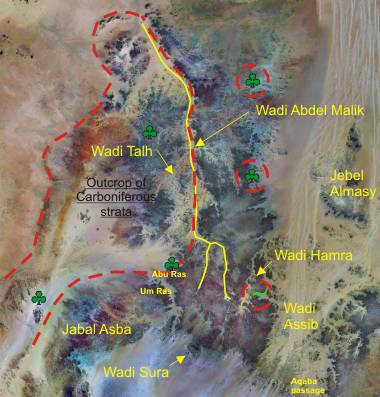
|
|
Wadi Thal area |
|

Striking horizons of red and white
Carboniferous layers (secondarily changed by leachate)
In the white layer is washed out the iron oxide, and in the red layers
underneath re-enriched
|
|

|

|
|

|

|
|

|

|
|
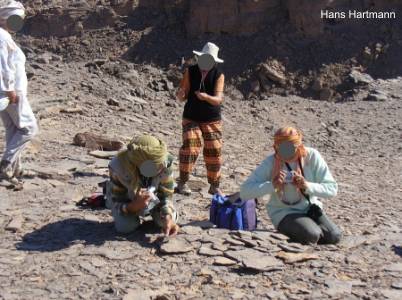
Plant rich layers on plateau top
(+750 m SL)
|

On the way to the location with
plants
|
|
|
| Author
2006: Wadi Thal area (24�10'N and 25� 13.5'E) |
|

Location with red shales
|

Warve-type sediments
|
|

|

|
|

|

|
|
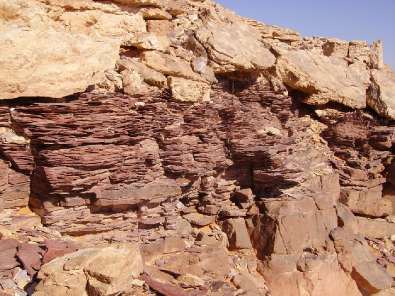
|

|
|

Bioturbation
|

|
| Author
2006: Northern Wadi Abdel Malik (24�34.5'N and 25�09'E) |
|

View to west
|

View to north
|
|

|
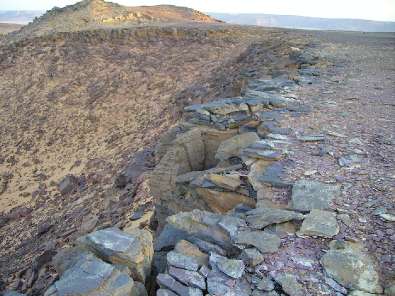
|
|

Coarse sandstone
|

Red shales on top
|
| U.
Steiner 2012: North-eastern forland of
Gilf Kebir |
New finds
of Lepidosigillaria imprints from the north-eastern Gilf Kebir in 2012.
Ursula Steiner and participants giving first detailed information to
the locality of Lepidosigillaria in the foreland of the north-eastern
Gilf Kebir (Wadi Gongoi), near the Great Sand Sea. The appearance
of the imprints indicates a fluvial-terrestrial facies. |
|

|
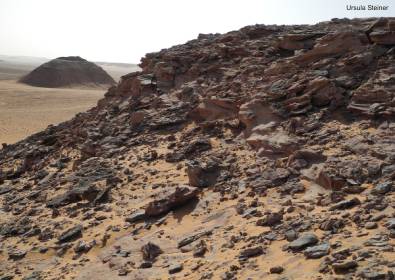
|
|

Location
|

Finds of Lepidosigillaria
|
|
Eastern edge of
Gilf Kebir |
|
Further evidence of Carboniferous
strata is available from the Wadi Hamra region and in the foothills
north of it. U. Steiner
(2012) photographed marine bioturbation and
A. Barakat
(1991) plant imprints.
|
|
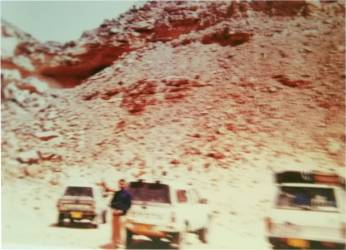

Soft bright layer with Sigillaria
plant imprints (24� 14.523 '/ 25� 27.014')
|

Locations of debris with bioturbation
|


|
|
U.
Steiner 2013/2014: Southern forland of Gilf Kebir |
|

A surprising location for many
questions .....
|

.... with
finds of Calamites (ferruginous)
|
|



|
|
Stalks of Cordaites (Wadi Wassa)
|
cf. Paleoweichselia (Wadi Wassa) |
|